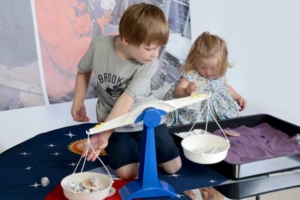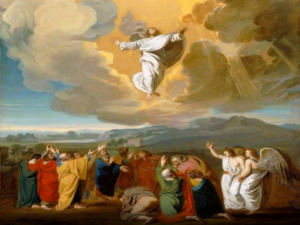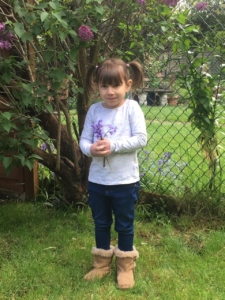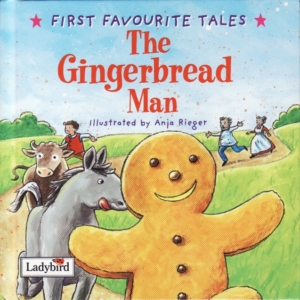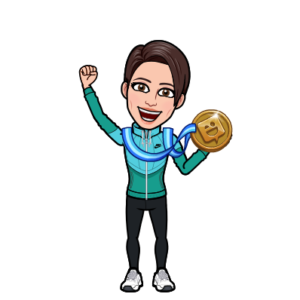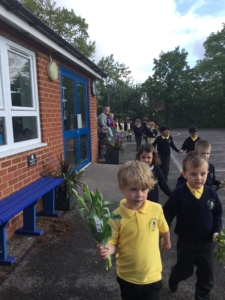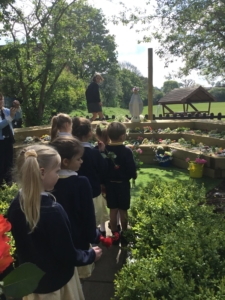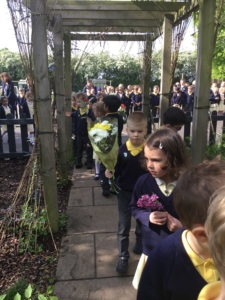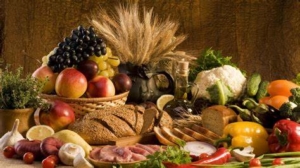Click on the links below to see video messages from Mrs Gymer and Mrs Theo!
Mrs Gymer message home

Dear Parents and Carers,
While going on my daily walks, I can’t help noticing just how many beautiful butterflies there are at the moment. With this is mind, I have decided that this week’s learning focus will be based on the book, ‘The Very Hungry Caterpillar’. I’m sure many of you will have this book in your homes, but if you don’t, the following link has a beautiful version of the story:
https://www.youtube.com/watch?v=75NQK-Sm1YY
The next following link is a lovely little film presented by children, about how a caterpillar turns into a butterfly. There is some scientific vocabulary that your child probably hasn’t heard before, but I personally think that this is a good thing! The footage itself is incredible and well worth watching.
https://www.youtube.com/watch?v=Lm-s168rW4s&feature=emb_rel_pause
Watch one of the class favourites -Come Outside. This episode is all about butterflies. https://www.youtube.com/watch?v=7l6nnv9ijBQ
As Friday is a bank holiday for VE Day, please take this opportunity to explain to your child what the day it is all about. (I know that they are very young and they may not understand much about it.)If you are celebrating it in anyway, please send me some photos on the class email address: yearR@popepaul.herts.sch.uk
*Remember, you do not need to do everything on this overview- even if you just pick one or two things to do from each area over the week, you will be doing a fabulous job!
Thank you for your continued support and have a great week!
Mrs Theo
__________________________________________________________________
This week’s theme is ‘The Very Hungry Caterpillar’

by Eric Carle
Personal, Social and Emotional Development (PSED)
- Make a large family hand print caterpillar.
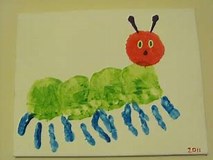
- Encourage your child to try some of the foods from the story and write about whether they like them or not.
- Talk about feelings – How might the very hungry caterpillar feel when he hatches out of the egg? When he’s trying to find food? When he metamorphoses into a butterfly?
- Look at how your child and the rest of the family have grown and changed since being a baby. Think about how your child will look as adults. Encourage your child to draw a picture of themselves as an adult.
Communication and Language
- Act out the story of the very hungry caterpillar.
- Make story props, and retell the story.
- Talk about our favourite fruit as a family and listen to others without interrupting.
- Discuss with your child, what they think will happen next. Where will the butterfly go now?
Physical Development
- Make caterpillars from: pom poms, socks, playdough, fingerprints, paper chains, cut out paper circles- all great for strengthening hand muscles!
- Thread a caterpillar necklace from a range of materials.
- Thread painted pasta onto pipe cleaners to make a caterpillar.
- Thread a pipe cleaner caterpillar through hole-punched leaves and food.
- Move like a caterpillar or a butterfly. Snuggle up like a cocoon.
- Fold paper to make a paper fan butterfly.
- Hide different coloured paper caterpillars and butterflies in the garden. Your child/siblings have to try and find their chosen colour. The first one to find all of their butterflies and caterpillars is the winner.
- Have fun getting your child to roll themselves up in a large blanket or sheet like a cocoon.
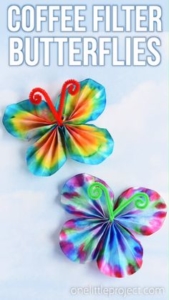
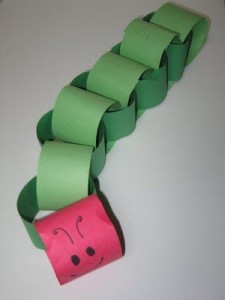
Understanding the World
- Watch the very hungry caterpillar on YouTube.
- Use the internet or non-fiction books to learn more about the butterfly life cycle.
- Make your own butterfly life cycle using different shaped pasta.
- Look for caterpillars and butterflies on your daily walk and take photographs of them.
- Draw and label the parts of a butterfly.
- Go on a leaf hunt; try and find leaves of different shapes.
- Make butterfly and caterpillar shadow puppets. What happens when you move your puppets closer or further away from the light?
- Look at the pattern on different leaves.
- Make a map of the very hungry caterpillar’s journey.
- Use the internet to find out what other animals undergo metamorphosis.
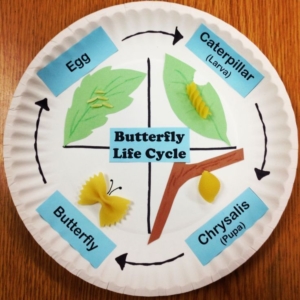
Expressive Arts and Design
- Make caterpillars and butterflies from a range of materials- see pictures.
- Leaf rubbings.
- Make a caterpillar mask.
- Collage pictures- just like in the book.
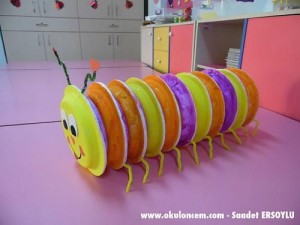
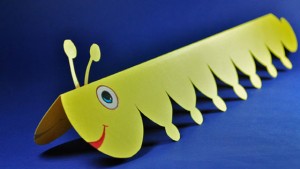
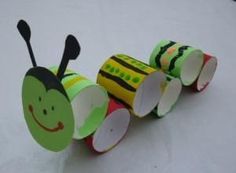
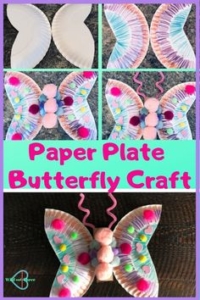
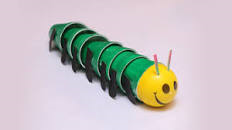
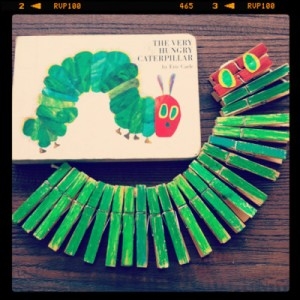
Maths
- Draw, cut out and measure different sized paper caterpillars.
- Sequence the life cycle of a butterfly in the correct order.
- Count out the right amount of the different fruits in the story, and set them out in the right order.
- Look at the patterns on butterflies Make different sized egg carton caterpillars. Use them for ordering, comparing and stacking.
- Create repeating patterns on the caterpillar’s body.
- Learn the days of the week in the right order. Match the food to the day of the week.
- Make a butterfly picture using different shapes.
- Make butterfly doubles. One wing has the numeral on; the other wing has the correct amount of different objects on.
- Make a picture graph of the food that the very hungry caterpillar ate.
- Make symmetrical butterfly paintings by painting one side only and folding the paper over.
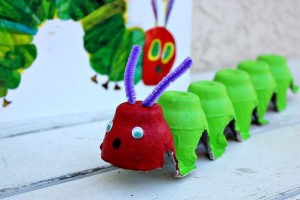
Parents, as tempting as it is, please try to limit the number of worksheets you give to your child as eventually, it will take the joy out of learning. The children are used to doing maths activities in a very practical way, both in the inside and outside learning environment. Rather than adding up pictures on a piece of paper, they could be adding up two piles of cars, two groups of daisies, goals scored altogether by two people etc. Thank you!
Literacy
Phonics- It is highly important that your child practises their letter sounds and tricky words and applies them through a reading and writing activity daily. Reading will help improve their vocabulary and a child’s academic success depends upon the ability to read and write and so this should be a priority.
Please do the daily Department for Education (DFE) ‘Letters and Sounds’ live phonics lesson.
Encourage your child to read and write for purpose:
- Write your own caterpillar life cycle.
- List the family’s favourite fruits and junk food.
- Design and write healthy living posters.
- Write a story about what happens to the butterfly from the story.
- Write about where you would fly to if you were a butterfly.
RE
To show that RE is a special learning time, we always light a candle to mark the beginning of lesson and ask ‘Who is with us when we light the candle?’ and ‘Who do we learn about in our RE lesson?’
We then say the school’s Mission Prayer together.

Please join in with the virtual May Procession accessed via the blog on Monday 4th May at 11am.
This week, we are focussing our RE learning on Mary, the Mother of God.
Begin by talking to your child about the following:
- That Mary is the Mother of God.
- That Catholics honour Mary during the Month of May because she is the Mother of God.
- That we crown our Lady’s statue during May and present her with flowers .
- That the Hail Mary is a prayer about Mary that we say often.
- That the Hail Mary is based on words and stories that were said in the Bible.
Remind your child of the story of the Annuncation. They will be familiar with it, due to the class Nativity.
Then choose from the following activities:
- Create an altar in honour of Mary at home for May – use pictures of Mary if you do not have a statue
- Make a crown for Mary.
- Colour in the story of the Hail Mary.
- Look at different pictures of Mary – which one do you like the best
- Paint a picture of Mary .
- Write out the Hail Mary and decorate it.
- Write your own prayer to Mary.
- Learn the Hail Mary.
The class also really enjoy singing the following songs during special prayer time:
https://www.youtube.com/watch?v=8fdk0oKMmfghttps://www.youtube.com/watch?v=Cc0QVWzCv9khttps://www.youtube.com/watch?v=DSpyKsPiUhs
https://www.youtube.com/watch?v=yjh5Kh5Hxu8
https://www.youtube.com/watch?v=QCN893hzueQ
https://www.youtube.com/watch?v=DXDGE_lRI0E
_________________________________________________________________________________
On-going further activities and information
Sing daily, using the BBC Schools Radio website- https://www.bbc.co.uk/teach/school-radio/eyfs-early-years/z6bgnrd Again, the class love this website and it will be very familiar to them!
On-going Maths Activities – try at least one a day
- Go on a walk and count how many rainbows or teddies you can see in the windows of different houses. Which road has the most?
- Counting objects within the house-This could be anything as simple as counting the cutlery in your drawer!
- Looking for shapes in the environment- Can you see the rectangle on the table? The square on the oven door? How many edges does the bookcase have? Can you name the 3D shape that your cereal box is?
- Using positional and directional language- Where is the teddy? On top, under, behind, in front of, next to, in between etc. Use directions to get from one room to another e.g. walk two steps forward, turn left…
- Capacity-Fill the bath and give them your child whichever containers you have at home (jugs, Tupperware). Encourage the language of full, nearly full, half full, nearly empty, empty. Will the water to fill this container fit into another container?
- Time- Create an ‘at home’ timetable together. What shall we do first? What shall do next? What shall we do at the end of the day? Begin to recognise o’ clock times on a clock.
- Money- Empty your purse or money box. Learn the names of the different coins. Use 1p coins to count and add with.
- Patterns- Use every day objects around the home to create patterns e.g. pen, fork, sock, pen, fork, sock. Can they continue and copy your pattern? Can they make their own pattern?
- Length and height- Find three objects from around the home. Can they order them from smallest to largest? Use your feet to measure the length of items in your home (e.g the sofa). How many feet long is it? Counting objects within the house. This could be anything as simple as counting the cutlery in your drawer!
- Addition using objects found within your home- If we have 5 spoons and 3 forks, how many do we have altogether? Include missing numbers e.g I have 5 buttons. How many more do I need to make 10?
- Subtraction using objects found within your home- If we have 7 biscuits and I eat 2 how many biscuits are left?
- Subitising (recognising how many without counting) the amount of objects in a set. How many candles are on the fireplace? How many plates are on the table? Etc
- Watch a Numberblocks episode each day at: BBC iplayer or CBeebies.
- Practise counting up to 20. This can be done through playing hide and seek, singing number songs, chanting, board games etc.
- Write out the digits 0 – 9.
- Sing Number songs to practice counting, reciting numbers in order, one more, one less using number songs: Five Little Ducks, Five Little Men, Ten Green Bottles
- Practise counting backwards from 20.
- Look for the numbers on the doors of houses. Do the numbers get bigger or smaller as you go up and down the street?
- Listen to a number song from the CBeebies website. After listening to them, watch again and sing along if you can. Talk about the maths you can see in the video clip.
- Look out of the window and count how many houses or buildings can be seen
- Explore weighing and measuring food on the kitchen scales. Ask, what happens as you place more on the scales?
- Look for numerals on packaging you find around the house. Can your child recognise the numerals and count out a matching amount?
Maths Websites
https://www.topmarks.co.uk/maths-games/5-7-years
https://matr.org/blog/fun-maths-games-activities-for-kids/
https://www.primarygames.com/math.php
https://www.bbc.co.uk/cbeebies/topics/numeracy
https://apps.mathlearningcenter.org/geoboard/
White Rose Maths have prepared a series of five maths lessons for each year group from Year R-8. They will be adding five more each week for the next few weeks. Every lesson comes with a short video showing you clearly and simply how to help your child to complete the activity successfully. Click on the link to find out more.
https://whiterosemaths.com/homelearning/
Independent writing
Parents, please encourage your child to write as often as you can, using their phonics and tricky word knowledge. Please take a close up picture of any writing they do and upload it to Tapestry. If they are forming their letters incorrectly, the wrong way around or hold their pencil the wrong way, please correct your child immediately. Please refer to the inside cover of their original home phonics book for the handwriting phrases, if you find yourself in this position.
Phonics
Please continue to practise all of Phase 2 and Phase 3 sounds and tricky words on a daily basis.
Phase 2 tricky and high frequency words
Read: is, it, in, at, and, the, to, no, go, I, on, a
Phase 3 tricky and high frequency words
Read: he, she, we, me, be, was, my, you, they, her, all, are
Write: the, to, no, go, I
For those children who know all of the above, please begin to teach the following words from Phase 4. (Consolidating phase)
Phase 4 tricky words
Read: said, so, have, like, some, come, were, there, little, one, do, when, out, what
Information about Phase 4 Phonics
During the summer term and only when the children are secure in Phase 2 and 3, Reception usually move over to the Phase 4 stage of Letters and Sounds. When children start, they will know a grapheme for each of the 42 phonemes. They will be able to blend phonemes to read CVC (consonant-vowel-consonant) words and segment in order to spell them.
Children will also have begun reading straightforward two-syllable words and simple captions, as well as reading and spelling some tricky words.
In Phase 4, no new graphemes are introduced. The main aim of this phase is to consolidate the children’s knowledge and to help them learn to read and spell words which have adjacent consonants, such as trap, string and milk.
If your child knows all of the Phase 2 and 3 sounds consistently and the high frequency and tricky words, then please begin to introduce your child to the Phase 4 online games and activities.
Important- Please be aware that if you go onto this phase before they are ready, it may cause your child to have issues with spelling later on in their school life.
The following websites are fantastic for practising phonics phases, word recognition and sentence reading.
https://www.teachyourmonstertoread.com
https://www.phonicsplay.co.uk/freeIndex.htm
https://www.phonicsbloom.com/
http://www.familylearning.org.uk
https://www.topmarks.co.uk
www.letters-and-sounds.com
https://www.spellingcity.com/spelling-games-vocabulary-games.html
Twinkl also have some great phonics and cross curricular resources and are also currently free if you follow these instructions:
Go to https://www.twinkl.co.uk/offer and enter the code: UKTWINKLHELPS
Phonics Play in particular is a fantastic resource for the actual teaching of the Letters and Sounds program. It is currently free to parents due to the Coronavirus situation.
Reading
As well as Oxford Owls, Harper Collins Publishers are now giving parents free access to their Big Cat e-books and activities, which are also organised according to book band colour.
Go to Collins Connect and click on the Teacher portal and enter:
Username: parents@harpercollins.co.uk
Password: Parents20!
and then click Login.
To login to Oxford Owl please continue using the school’s login.
https://www.oxfordowl.co.uk/
Username:popepaul2020
Password:Ilovereading2020
You must put the detail into Class Login not the general login otherwise it will not work. Once logged in, you can go into the bookshelf. Select 2 books from your child’s book band colour and practise reading them every day. There are two activities to go with each book and parent tips at the end of the book. If you click on the parents section too, you should find even more books and resources.

 Dear Parents and Carers,
Dear Parents and Carers,
